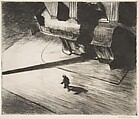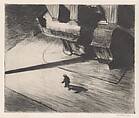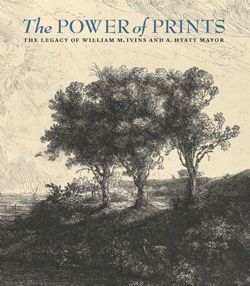Night Shadows
Edward Hopper American
Not on view
In this print, the viewer is given a bird's-eye perspective of a city street corner. Hopper has evoked an entire world with just a few elements: a storefront, a fire hydrant, and a lone walking man who is about to cross the looming shadow of a streetlight that lies across his path. The setting that inspired Hopper was an actual location in New York, which the artist also used for his oil painting New York Corner (also known as Corner Saloon, 1913; Museum of Modern Art, New York). It is a downtown street near the riverfront, marked by a simple brick building with a painted sign; yet as ordinary as this place may be, Hopper has made it seem mysterious and even threatening through the use of dark tonalities and strong compositional devices. The viewer becomes a voyeur, watching the unaware pedestrian, and a possible narrative of the man's destination at this late hour (when even the saloon is closed) extends beyond the single moment of the image. Hopper's sensibility in such a work as Night Shadows forecasts the film noir style of the 1940s, with its shadowy lighting and its narratives of crime, guilt, and betrayal.
Although the imagery of Night Shadows is characteristic of Hopper's work, this etching is unusual in his oeuvre in one respect. He normally printed his own works, in very small numbers; in this case, however, a commercial printer "steel-faced" the etching plate of Night Shadows for longer wear, and printed a large edition of several hundred images. The resulting etchings were included in a folio titled "American Etchings," published in the December 1924 issue of the New Republic.
This image cannot be enlarged, viewed at full screen, or downloaded.
This artwork is meant to be viewed from right to left. Scroll left to view more.






